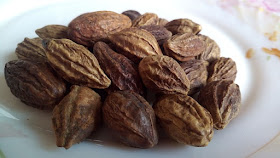ARJUN
Terminalia arjuna is a miracle tree which was used during ancient times to cure heart problems. Terminalia arjuna Wight & Arn. Is popularly known as arjuna.
All the parts of the Arjuna have been used for their therapeutic beneficiary effect. Terminalia arjuna helpful to maintain healthy heart and reduce the effects of hassle and nervousness.
It has antibacterial, antimutagenic, hypolipidemic, antioxidant and hypocholesterolaemic and antiinflammatory effects. Terminalia arjuna have the ability to protect the liver and kidney tissues against CCl4 induced oxidative stress by increasing antioxidative defense activities.
Different types of bioactive compounds have been isolated from this medicinal plant possesses enormous value in medicine among then arjunolic acid is very well known. The plant parts T. arjuna are used in indigenous system of medicine for different ailments.
- The bark powder has been invent to possess anti-ischemic, antioxidant action, cardioprotective properties, hypercholesterolemia effect, fungicidal and antibacterial, antimicrobial, Anti-inflammatory, immunomodulatory and antinociceptive activity, Arjuna also useful to treat obesity, hypertension and hyperglycemia.
- The higher antioxidant potential of T. arjuna stem bark is due to the presence of higher amount of phenolic and flavonoids.
The Terminalia arjuna is one of the best heart tonic
therefore, it can be used daily as tonic for healthy cardiovascular system.
Ayurvedic Aspect
1. Charka samhita:- Kashayskandh(bitter taste), Udardaprashman, mahakashya
2. Sushrut samhita:-
Nyagrodhadi, Salsaradi
3. Ashtanga hridaya:- Nyagrodhadi, Salsaradi
4. Bhavprakash nighantu:-Vatadi varg
5. Dhanvantari nighantu:-Amradi varga
6.Kaiyedu Nighantu:-Aushadadi Nighantu
7.Raj Nighantu:-Prabhadhadri varga
Vernacular Names
Hindi- Arjun, Arjuna, Koha, Kahu, Arjan.
Gujrati- Arjun - Sadada, Sadado.
Marathi- Arjuna, Arjun Sadada, Sadura.
Sanskrit- Arjuna, Dhanvi, Indradruma, Kakubha, Karvirak..
Oriya- Arjuna Sahajo.
Tamil- Vellamatta.
Telugu- Yerramaddi.
Assam- Orj un
Bengali-Arjhan.
Punjabi- Arjuna
Habitat
It is found in Himalaya, Bangal, Bihar, Mostly found in Madhya Pradesh,
Rasa Panchaka of Arjuna
Rasa -Kashaya
Guna-Laghu, Ruksha
Virya-Shita (Cold)
Vipaka –Katu
Prabhav-Hrudya
Dosh Kanata-kapha pitta shamak
Morphology
Bark -of Terminalia arjuna is simple, grey and smooth on external surface and it is thick, soft and of red color from inside.
Leaves-Terminalia arjuna Leaves are like Guava leaves, they are oblonged, (4-6 inch) long and (2-3 inch) wide, subopposite, glabrous and often inequilateral. There are two glands present near the base of the petiole. The base is rounded or cordate.
Flowers- Terminalia arjuna flower white or yellowish color flowers are found in groups.
Flowering of Terminalia arjuna occurs in summer and fruits appear in winter or spring season.
 |
| Flower of Arjun |
Fruits- Fruit is drupe and is often notched near the top, marked with oblique upward curving striations. The fruits are (1-1.5) inch in diameter and with 5-7 longitudinal lobes. These are glabrous with five to seven wings, woody and fibrous.
 |
| Fruit of Arjun |
Useful parts:- Bark
Modern aspect
Taxonomical Classification
Kingdom-Plantae
Division-Magnoliophyta
Class-Magnoliopsida
Order-Myrtales
Family-Combretaceae
Genus-Terminalia
Species-T. arjuna
English Name-White Marudah
Chemical Composition
Terminalia arjuna contains phenols, flavonoids, tannin, saponin, alkaloids, glycosides, phytosterols and carbohydrates, Arjunetin, Fridelin.
Traditional uses
Following conditions in which Arjuna is extremely beneficial.
Cardio modulator
Blood pressure
Hyperlipidemia
Hyperlipidemia
Hypercholesterolemia.
Reduces stress
Liver tonic
Urinary tract toner.
MEDICINAL USES
Terminaliaarjuna is a wide spread medicinal plant. The different parts of Terminalia arjuna like bark, leaves and fruits etc., Have different medicinal values and are used to cure various diseases. The bark is the main part used in ayurveda as well as in Allopathy for curing various diseases. The bark of arjuna tree contains calcium salts, magnesium salts and glucosides have been used in traditional ayurvedic herbalism According to vagbhata, Terminalia bark is cooling, kaphapitta, pacifying, cardiac restorative and help in healing wounds, tuberculosis and poisoning. Chakradatta advised to take it by processing in milk for cardiac disorders alone or with panchamula.
Arjun for cardiac support
In Ayurveda, bark powder is used as cardio protective and it is known as a tonic to heart
diseases. Its ksheerpaka is highly effective to normalize high blood pressure and in many rural areas.
Cardiomyopathy like myocardial infarction, Angina, coronary artery diseases, heart failure,
hypercholesterolemia, and hypertension are cured by arjuna bark powder.
Used as an ischemic and cardio protective agent in hypertension and ischemic heart diseases.
Arjuna improves pumping capacity of heart by strengthening muscles and vascular system
and also be useful in treating excess cholesterol in blood. The anticoagulant and antiplatelet aggregation action of arjuna keeps the blood thin and lowers the bad cholesterol while increasing the good cholesterol.
In high blood pressure it helps to regulate disturbed rhythms and regulate the heart beat rate.
Arjuna reduces the effect of stress and nervousness on the heart. It provides significant
cardiac protection in heart attack.
Although many ayurvedic plants have shown to help coronary artery diseases, Arjuna by far seems to be the best plant for heart health.
Other medicinal uses
It works as a wonderful full antioxidant so it helps in stopping early aging and helps in maintaining youth.
FORMULATIONS OF ARJUNA IN AYURVEDA









